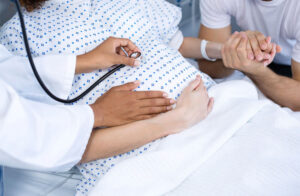Ectopic pregnancy
By Dr. Asmaa Abdulsalam Consultant of Obstetrics and Gynecology at Al Ahli Hospital

Ectopic pregnancy is a common complication and leading cause of maternal morbidity and mortality early in pregnancy. Ectopic pregnancy is defined as implantation of the fertilized ovum away from the normal site which is the endometrium lining of the upper uterine segment.
Diagnosis
Clinically, diagnosis of ectopic pregnancy is sometimes confusing and challenging as no ectopic is like another ectopic, the differential diagnosis of ectopic pregnancy should be always in the mind of the physician dealing with early pregnancy, i.e. Physician should exclude ectopic pregnancy in every woman in reproductive period, coming for the first antenatal visit or coming with vaginal bleeding and abdominal pain.
The diagnosis is made based on:
First: taking detailed medical, surgical, obstetrical and gynecological history.
Second: symptoms; including missed period, irregular vaginal bleeding, lower abdominal pain which sometimes refers to the back and shoulder, associated with fainting attacks and dizziness, pain can also be felt lower in the perineum and anus.
Third: signs; including lower abdominal tenderness, guarding and rebound tenderness, pain on moving the cervix, and sense of fullness of Douglas pouch, while doing a vaginal examination.
Fourth: Laboratory tests; BHCG (pregnancy hormone) is essential in the diagnosis of pregnancy, in normally growing pregnancy, BHCG hormone should double every 48 hours, so if it fails to show doubling, it is an indication of embryonic demise whether intra or extrauterine.
Fifth: Then comes the role of ultrasound to locate the site of the ectopic, so High BHCG level with an empty uterine cavity is considered diagnostic of ectopic pregnancy. In addition to other findings such as Adnexal mass or hematoma, presence of adnexal gestational sac with an embryo with or without heartbeats and in severe cases free blood in Douglas pouch and the abdominal cavity can be seen.
Common sites of Ectopic pregnancy
Most commonly it is located in Fallopian tubes, but it can be in Douglas pouch, ovaries, cervix, Cornual part of the uterus and in rare cases in the Omentum or the intestine. Recently due to increased incidence of cesarean sections, ectopic pregnancy can occur at the scar of the previous cesarean section.
Causes of ectopic pregnancy
Any reason that will make the journey of the fertilized ovum longer than 7 days, from the time of fertilization at the lateral third of the fallopian tube till implantation in the upper part of the uterus, will cause ectopic pregnancy. So, infections and adhesions in fallopian tubes will distort the pathway preventing the fertilized ovum from reaching its destination at the proper time subsequently it will start implantation in an abnormal place. The adverse effect of hormones on the movements of the fallopian tubes and the cilia lining the inside the tubes is well known. So, slowing of the peristaltic movement of the tubes under the effect of exogenous sex hormones may result in ectopic pregnancy.
Who are at risk of having an ectopic pregnancy?
Women with a previous history of ectopic pregnancy, history of Invitro fertilization and assisted reproductive techniques, those using progesterone intrauterine devices and those with a history of pelvic inflammatory diseases and salpingitis are considered at high risk of having an ectopic pregnancy.
Treatment of Ectopic pregnancy
Since the clinical picture differs from one woman to another the treatment will also vary based on the severity of the clinical symptoms, signs and the wish of the woman to preserve her fertility as possible.
Type of treatment depends also on the degree of cooperation of the woman and the feasibility to follow her up close. Another determinant is the availability of certain equipment and laboratory tests, so the physicians in rural poorly equipped parts of the world or in conflict areas may proceed into surgical options rather than a conservative one. In other words, management should be tailored for each woman individually, the plan of management and the impact of this plan on the woman ‘s fertility should be extensively discussed and explained in detail to the woman. So, treatment can be; Expectant conservative, Medical conservative, or Surgical. The physician should be flexible in changing the plan according to the progress of the disease and the response of the patient to each type of treatment.
Expectant management: No medical or surgical intervention will be done there will be only close follow up of the symptoms, signs, general condition of the woman and serial measurement of BHCG level in serum every forty-eight hours and repeated ultrasounds till BHCG is zero.
The idea behind expectant management is that ectopic pregnancy will be aborted from the tubal end into the peritoneal cavity with minimal bleeding that will be absorbed by a peritoneal cavity, resembling early intrauterine pregnancy demise which will be aborted with minimal bleeding,
To be able to implement such expectant treatment, patients should be completely vitally stable, free of symptoms, showing understanding of the symptoms and signs as the disease progresses, has full access to the medical care in case of emergency, level of BHCG should not exceed 1000 IU, and the size of the adnexal mass should not exceed 3 cm.
Medical treatment: This is another way to avoid surgical intervention and preserve fertility as possible while treating ectopic pregnancy. The drug of choice is the Methotrexate injections in single or multiple shots following a certain algorithm with close follow up of the patient till BHCG is again zero. The idea behind is to stop trophoblasts from growing and invading blood vessels in a tissue which is not prepared for implantation, like expectant management the patient should be followed closely with BHCG not more than 5000 IU, and the size of the adnexal mass not more than 4 cm, without cardiac activity; again, the patient should be absolutely vitally stable with minimal tolerable symptoms.
Surgical treatment: Mostly done through laparoscopy but in a certain situation could also be done by minimal laparotomy. It aims to excise the ectopic pregnancy and damaged tissue and to stop bleeding. Again, the affected tube can be removed completely (salpingectomy) or incised to remove the ectopic pregnancy leaving the tube in place after proper hemostasis (salpingostomy). However, the studies showed no real difference in both techniques when it comes to future fertility.
Surgical treatment is mandatory whenever:
- The vital signs are not stable with the deterioration of the general condition of the woman showing hypotension and tachycardia.
- If the patient is complaining of severe abdominal pain.
- When the ultrasound shows living embryo outside the uterine cavity or adnexal mass of more than 4 cm.
- BHCG level is above 5000 – 10000 IU.
- The presence of active intraperitoneal bleeding.
- Increase of BHCG level of 50% per 48 hours, or continues rise of BHCG level in spite of giving Methotrexate.
- Again, BHCG follow-up is mandatory till BHCG is zero.
Conclusion
Ectopic pregnancy is a serious complication and leading cause of maternal morbidity and mortality in the first trimester of pregnancy.
The key to early diagnosis and treatment is to always work on and to exclude the possibility of ectopic pregnancy whenever dealing with women in the reproductive age group.

















